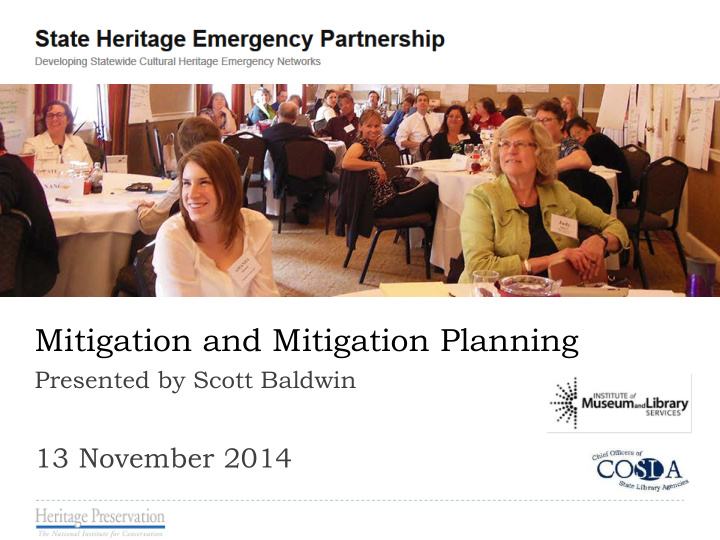



Mitigation and Mitigation Planning Presented by Scott Baldwin 13 November 2014
heritagepreservation.org/shep
heritagepreservation.org/shep
QUESTIONS? Lori Foley lfoley@heritagepreservation.org Katelin Lee klee@heritagepreservation.org 202.233.0800
Today’s Instructor Scott Baldwin Mitigation Specialist, Colorado Division of Homeland Security and Emergency Management
Mitigation and Mitigation Planning Presented By The Division of Homeland Security and Emergency Management
What We Will Cover • State and Local Hazard Mitigation Planning Process • What your organization can do to mitigate disaster and environmental impacts • Private Non-Profit mitigation funding eligibility • Communication strategies for engaging Emergency Managers
What is Hazard Mitigation? • Mitigation: “sustained action taken to reduce or eliminate long-term risk to people and property from hazards” • Local hazard mitigation plans form a foundation for communities seeking to reduce risks from hazards to people, property, and infrastructure.
The Stafford Act and DMA 2000 • The Robert T. Stafford Disaster Relief and Emergency Assistance Act, as amended by the Disaster Mitigation Act of 2000 (DMA 2000), provides the legal basis for State, local, and Indian Tribal governments to undertake a risk-based approach to reducing risks from natural hazards through mitigation planning.
DMA 2000 Continued • DMA 2000 provides an opportunity for States, Tribal Governments, and local jurisdictions to significantly reduce their vulnerability to natural hazards. • An opportunity to comprehensively assess your risks and develop a strategy to reduce those risks • It places emphasis on State, Tribal, and local mitigation planning by requiring these entities to develop and submit mitigation plans as a condition of receiving various types of federal assistance.
What Are the Benefits? • Eligibility for FEMA grant programs, including: – Pre-Disaster Mitigation (PDM) – Flood Mitigation Assistance (FMA) – Hazard Mitigation Grant Program (HMGP – Post-Disaster) – Private Non-Profits are only eligible for post-disaster mitigation assistance
Eligible Activities – HMGP • Planning • Wildfire • Acquisition/Elevation • Flood Control • Generators • 5% Projects – public awareness campaigns, warning systems, building codes
The Stages of the Mitigation Plan 1. Planning Process/Organizing Resources 2. Hazard Identification and Risk Assessment 3. Mitigation Strategies 4. Plan Adoption Monitoring and Evaluation *Note: Federal regulations pertaining to local mitigation planning can be found in § 44 CFR 201.6. FEMA “How to” guidance can be found on FEMA’s website
Planning Process • Establishing stakeholders and the Planning Team – Should include (but not be limited to): • Fire • Jurisdiction political/ administrative leadership • Parks • Members from Each Participating • Emergency Management Jurisdiction (for multi-jurisdictional • Planning plans) • Public Works/Engineering • Academia • State and Federal Partners • Local Non-profits and businesses Floodplain Management • Citizens – It is important that as many departments as possible are involved – they play a central role in effective implementation of mitigation projects
Benefits of Plan Participation • Advocacy – – Your organization – Cultural and Historic Resources • Subject matter expertise • Develop community relationships
• During the next few slides think about how Hazard Identification and Risk Analysis (HIRA) and mitigation strategies could be applied to your institution/ organization
Hazard Identification and Risk Assessment • Hazard Identification – Provide descriptions of all natural hazards affecting the jurisdictions • Human-caused, public health, and zoonotic hazards can be included as determined by local priorities, but they are not required – Analyze how hazards vary across jurisdictions, if applicable
Hazard Identification and Risk Assessment Profiling Hazards • Location – Where are the areas of highest risk to a given hazard? • Magnitude/severity (Extent) – i.e. wind speed, depth and duration of flooding, peak ground acceleration (earthquake) • Historical hazard events • Probability of future events
Mitigation Strategies • Mitigation Action matrix should include: – Identified action – Action priority – Corresponding hazard – Jurisdiction implementing the action – Responsible agency/department – Potential funding source – Timeline
Sound Collection Care • Incredible amount of overlap between collection care and disaster preparedness • Thorough inventory of collection • Know location of important items and ensure they are stored properly • Know your insurance coverage • Develop an Emergency Plan – WESTPAS • Continually train staff
Disaster Preparedness - Partnerships • Develop local and regional partnerships to assist each other during a disaster • It is likely your staff will be impacted personally by the event
Emergency Management Engagement • Response Priorities – Life Safety – Property – particularly primary residences • You must advocate for yourselves – Your institutions and their contents are valuable and intrinsic to your community’s recovery. • You must be adaptable/flexible
Emergency Management Engagement • Relationship building – reciprocity – Explain how you can assist in a disaster – You all have subject matter expertise – This expertise is an incredible asset – Facility walk-throughs – Exercises – Planning (Emergency, Mitigation)
Questions?
Please complete our webinar evaluation by Wed., Nov. 26 https://www.surveymonkey.com/s/QGSF9N7
Join us for our next webinars! 3:00 – 4:30 pm Eastern Thursday, November 20, 2014 Disaster and Continuity Planning and Preparedness Kiran Dhanji, Section Administrator, Preparedness, Texas Division of Emergency Management Wednesday, December 3, 2014 Federal Disaster Recovery Assistance from the U.S. Small Business Administration (SBA) for Private, Nonprofit Organizations Mark Randle, SBA Public Information Officer
Thank you! www.heritagepreservation.org 1012 14 th Street, NW, Suite 1200 Washington, DC 20005 202-233-0800
Recommend
More recommend